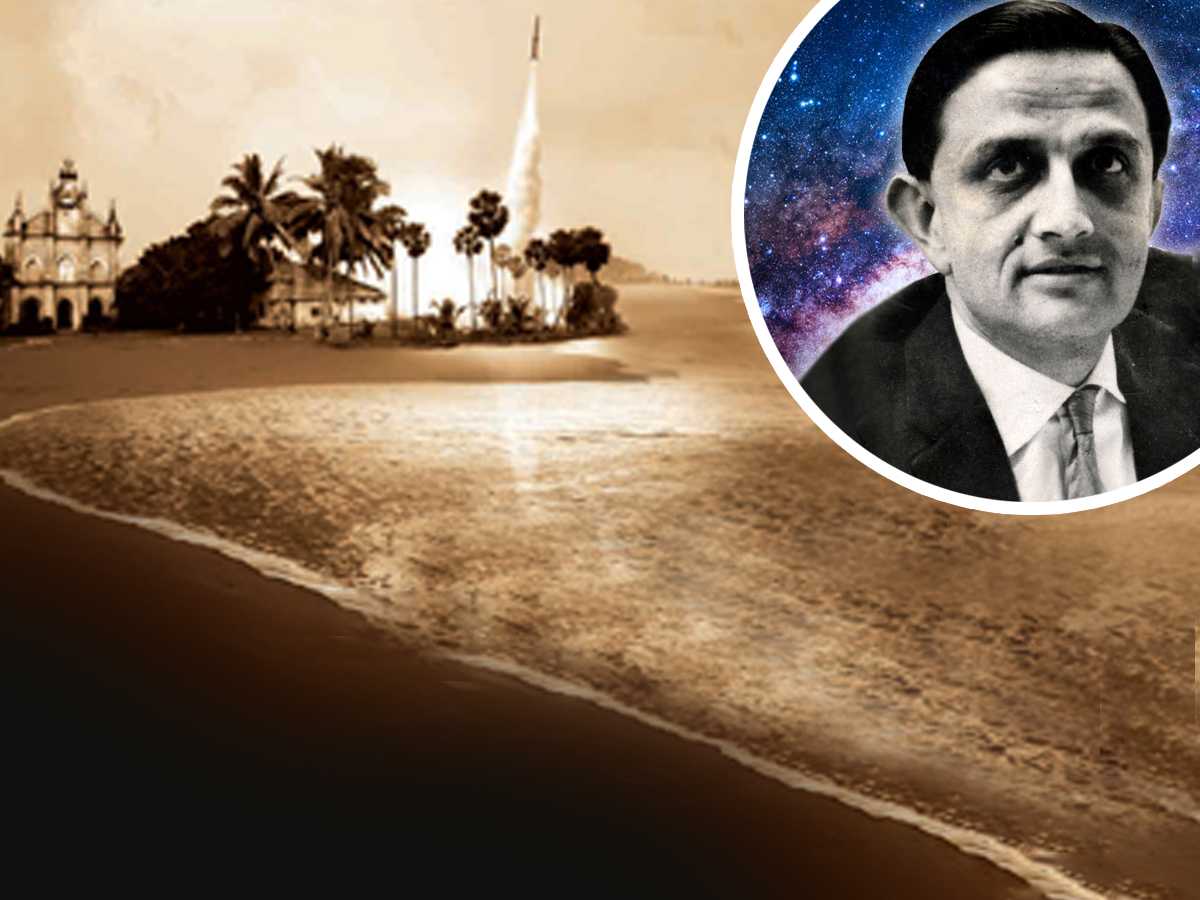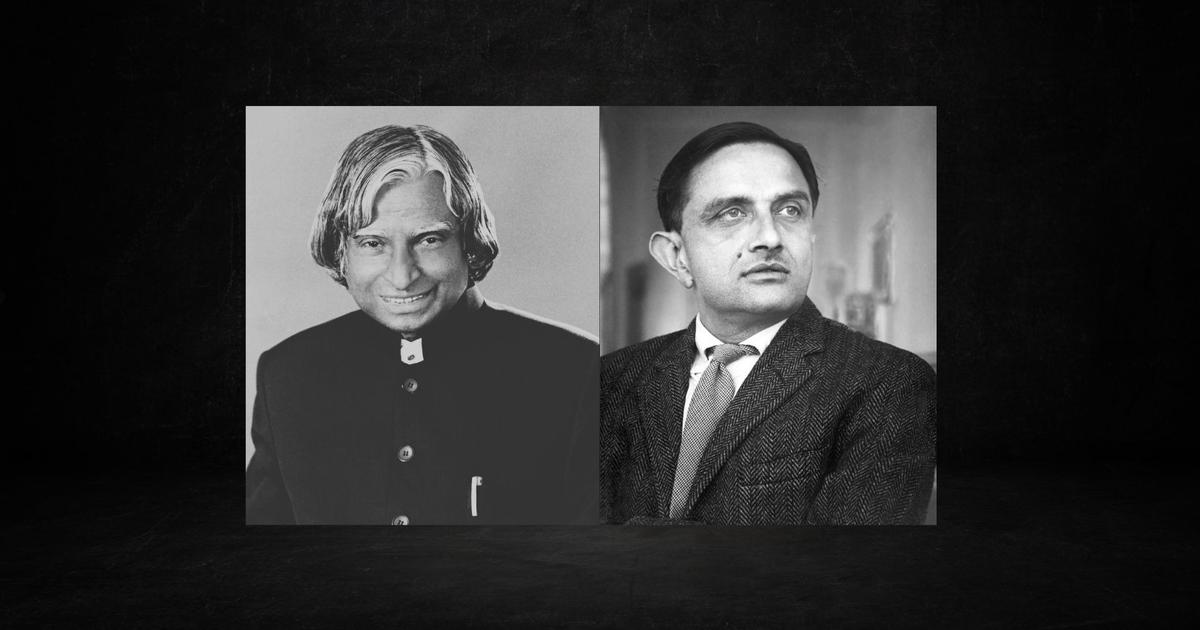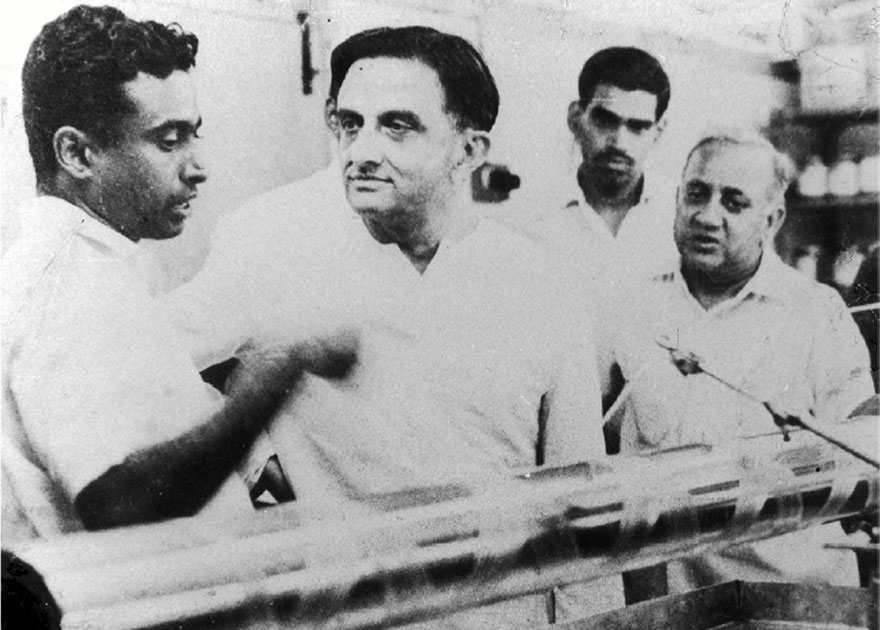“See the beauty in science, embrace the wonders of exploration, and remember that the future lies in your hands. May your curiosity and innovation shape a brighter tomorrow.”
– Dr. Vikram Sarabhai
In the early lives of two extraordinary individuals, Dr. Vikram Sarabhai and Dr. APJ Abdul Kalam, destiny wove a story that would not only change their trajectories but also alter the course of Indian science and technology. Their journey of mentorship, marked by a serendipitous meeting and a shared vision, serves as a testament to the transformative power of guidance and inspiration.
Dr. Vikram Sarabhai, born in 1919, was a brilliant scientist and visionary who had a profound impact on India’s space program. His childhood was steeped in an environment of learning and intellectual curiosity, as he hailed from a family of scientists and scholars. Sarabhai’s education and experiences abroad, including his time at the University of Cambridge, exposed him to cutting-edge scientific advancements, which he yearned to bring back to his homeland.
On the other side of this mentorship equation stood a young boy from Rameswaram, Tamil Nadu, named Abul Pakir Jainulabdeen Abdul Kalam, who would later be affectionately known as the “Missile Man of India.” Humble beginnings marked Dr. Kalam’s early life, however, his unwavering determination and thirst for knowledge propelled him toward a remarkable future.
The paths of these two visionaries crossed in the early 1960s when Dr. Kalam, a recent graduate with a degree in aerospace engineering from the Madras Institute of Technology, set his sights on India’s nascent space research program. Dr. Sarabhai, the driving force behind the Indian National Committee for Space Research (INCOSPAR), was actively seeking bright minds to join this ambitious endeavor.
In his book, The Wings of Fire, Dr. Kalam wrote, “At different times in our life, teachers and mentors enter our lives. I was incredibly fortunate to enter Dr. Vikram Sarabhai’s orbit as my career was just getting started.”
Dr. Sarabhai was one of contemporary India’s finest thinkers and doers. He was a scientist, educator, institution builder, and visionary. He possessed both the traits of a great leader and a keen intellect. He was selected to lead the nation’s fledgling space program following Independence, which proved fortunate for the nation.
Their shared vision for India’s progress in space technology, coupled with Dr. Sarabhai’s mentorship and Dr. Kalam’s unwavering commitment, laid the foundation for one of the most dynamic and impactful partnerships in the history of Indian science and technology. Together, they embarked on a journey that would not only shape their destinies but also leave an enduring legacy for generations to come.
The Meeting of Two Visionaries
Dr. Kalam first met Dr. Sarabhai when INCOSPAR called him for a job interview as a rocket engineer. When Professor M.G.K. Menon of the Tata Institute of Fundamental Research (TIFR) saw his work on the Nandi hovercraft in Bangalore, he unexpectedly called Kalam for an interview. He wasn’t sure who would be doing the interview or what to expect from it. Life had previously shown him that the key to success is to remain composed and open to new challenges rather than obsessing over victory.
Dr. Sarabhai, Professor Menon, and Mr. Saraf, the Atomic Energy Commission’s deputy secretary, all interviewed him. Although the warmth and graciousness he experienced in the room were extraordinary, each of them was a treasure trove of scientific information. The tone of that interview determined how he would interact with Dr. Vikram Sarabhai going forward. He dug further into Kalam’s thoughts in an effort to understand not only his level of knowledge but also who he was as a person, his aspirations, and the potential for development he had both personally and professionally.
Dr. Vikram Sarabhai recognized the immense potential in the young Kalam and took him under his wing. He not only nurtured Kalam’s scientific acumen but also instilled in him a passion for space research and innovation. Sarabhai’s forward-thinking approach and emphasis on originality were instrumental in shaping Kalam’s perspective on science and technology.
The Confluence of Science and Spirituality

Kalam’s journey into INCOSPAR (Indian National Committee for Space Research) marked a turning point in his life, a dream realized for the young aerospace engineer. As he immersed himself in his new role, he couldn’t help but notice the stark contrast between his current environment and his previous experiences. Here, hierarchy and rigid labels held less sway, creating a fertile ground for innovation and exploration—a setting that would define a remarkable chapter in India’s scientific history.
Shortly after joining INCOSPAR, Dr. Kalam encountered a story that would forever captivate his imagination—a tale of visionary determination and spiritual synergy. It was the story of how Dr. Vikram Sarabhai, the founding father of India’s space program, established the Thumba Equatorial Rocket Launching Station (TERLS) in the picturesque town of Thumba, Kerala, in 1962.
Thumba was chosen for its strategic location near the equator, ideal for ionospheric and atmospheric research. However, acquiring the necessary land for scientific pursuits was no easy task. The area was inhabited by numerous fishing communities, and the charming St. Mary Magdalene Church, nestled beside the bishop’s residence, graced its landscape.
Dr. Sarabhai’s determination faced bureaucratic hurdles and challenges in securing permissions for research facilities. Advised to seek the support of Reverend Father Dr. Peter Bernard Pereira, the bishop of Trivandrum, he met with him on a fateful Saturday. The bishop, perceiving the harmonious convergence of science and spirituality for the greater good, requested a congregation meeting the following Sunday after the church service.
On that significant Sunday, before the congregation, the bishop presented Dr. Sarabhai’s proposal to dedicate the church and its surroundings to the pursuit of space science. He eloquently articulated, “My children, science seeks truth through reasoning, and science and spiritualism both seek divine blessings to do good. My children, can we offer God’s abode for a scientific mission?” The resonating ‘Amen’ from the congregation sealed the noble decision.
Reverend Dr. Peter Bernard Pereira’s act of dedicating the church building to India’s mission of establishing ISRO (Indian Space Research Organization) became the cornerstone of India’s space program. The church premises evolved into a design center, a site for rocket assembly, and even a residence for scientists. Over time, this historic church transformed into the Indian Space Museum, serving as a poignant reminder of India’s space odyssey’s humble beginnings.
This harmonious collaboration between science and spirituality, spearheaded by enlightened leaders, served as an inspirational message for Kalam as well as the generations. It is a testament to the integration of minds and the transformative power of a shared vision, making it a unique and powerful symbol of the unity of diverse forces for the common good.
Food for Thought for Leaders

As a brilliant aerospace engineer Dr. Kalam found in Dr. Sarabhai not just a mentor, but a visionary leader who would shape not only the course of his career but also the destiny of a nation. His influence reached far beyond the confines of laboratories and rocket launch sites, extending to the very core of those fortunate enough to work under his guidance. Leaders can glean several valuable lessons from the mentorship between Dr. Vikram Sarabhai and Dr. APJ Abdul Kalam.
Incentivizing failure
During one of Dr. Sarabhai’s visits to the Thumba Equatorial Rocket Launching Station (TERLS), where Dr. Kalam was actively involved, a significant demonstration was planned. It involved showcasing the nose-cone jettisoning mechanism of the Satellite Launch Vehicle (SLV) stage they were working on. The plan was for Dr. Sarabhai to press a switch, activating the pyrotechnic system through a timer circuit, which would release the nose cone.
When Dr. Sarabhai pressed the switch as requested, nothing happened. This unexpected failure could have led to frustration and disappointment, however, Dr. Sarabhai approached it differently. Instead of admonishing the team, he engaged them in a thoughtful conversation. He probed deeper, asking questions about their enthusiasm for the project and whether it challenged them enough.
This discussion didn’t just stop at diagnosing the issue; it led to a profound insight. Dr. Sarabhai recognized that what was lacking was a dedicated space for the system integration of all their rocket stages and systems. This recognition, born out of a willingness to listen and engage with his team, sparked innovation. Dr. Sarabhai stayed up late into the night, working with Dr. Kalam and others to redefine roles and create a new department—the Rocket Engineering Section.
Foresightedness
In the early 1960s, when Dr. Sarabhai was envisioning the establishment of the Thumba Equatorial Rocket Launching Station (TERLS) and the development of satellite launch capabilities, these ideas might have seemed unrelated at first glance. However, Dr. Sarabhai possessed the visionary capacity to see the interconnectedness of these initiatives and their far-reaching implications.
He recognized that the launch of satellites into space required not only rocket technology but also the scientific understanding of Earth’s upper atmosphere. This realization led to the selection of Thumba in Kerala, near the equatorial region, for TERLS. Thumba’s location made it ideal for ionospheric research in the upper atmosphere, aligning perfectly with Dr. Sarabhai’s vision.
This foresight paved the way for India’s foray into space science, telecommunications, meteorology, and education. Dr. Sarabhai’s ability to link seemingly unrelated concepts—like rocketry and ionospheric research—demonstrates the power of creative thinking and holistic vision. His mentorship conveyed to Dr. Kalam and others the importance of exploring unconventional solutions and inspiring teams to pursue ambitious goals that could lead to groundbreaking advancements.
Promoting synergy
During the formative years of India’s space program, Dr. Sarabhai recognized the need for a talented and dedicated team of scientists and engineers. He displayed an uncanny ability to spot potential, often looking beyond experience and seniority. Dr. Kalam himself was a young and relatively inexperienced engineer when he joined INCOSPAR.
Dr. Sarabhai’s approach was to nurture a sense of belonging and empowerment within his team. He instilled a shared vision and purpose, making every member feel like an integral part of the larger whole. This approach not only motivated the team but also encouraged them to innovate and push boundaries.
As a result, the team at INCOSPAR was a dynamic mix of young, enthusiastic engineers and seasoned scientists. Dr. Sarabhai’s leadership style created an environment where everyone believed in their contribution to a common goal. This cohesive and high-performing team laid the foundation for India’s remarkable achievements in space exploration.
Identifying and nurturing talent
In the early days of India’s space program, Dr. Sarabhai entrusted Dr. Kalam with a pivotal role that went beyond traditional notions of hierarchy. At that time, Dr. Kalam was a relatively junior engineer at INCOSPAR. However, Dr. Sarabhai recognized his potential and entrusted him with the responsibility of leading a critical project—the development of India’s first satellite launch vehicle, the Satellite Launch Vehicle (SLV).
This decision to empower a young engineer with such a significant leadership role was unconventional and challenged the typical top-down approach. Dr. Sarabhai’s foresight demonstrated that leadership is not confined to titles or seniority but is about identifying individuals with the right skills, passion, and dedication.
Under Dr. Sarabhai’s mentorship, Dr. Kalam not only successfully led the SLV project but also went on to become one of India’s most renowned scientists and leaders. It serves as a compelling lesson for leaders in recognizing and harnessing the untapped talent within their teams, ultimately leading to a more dynamic and adaptive workforce.
Enabling the best-self of others
When Dr. Sarabhai initiated the development of India’s space program, it encompassed a wide range of scientific and technical domains, including rocketry, materials science, aeronautics, and more. Dr. Sarabhai recognized the importance of bringing together experts from these diverse fields to work collaboratively toward a shared vision.
Under his mentorship, interdisciplinary teams were formed to address complex challenges and innovate solutions. This approach not only fostered cross-pollination of ideas but also encouraged individuals with varied expertise to contribute their unique insights.
One notable outcome of this integration was the development of India’s own Satellite Launch Vehicle (SLV), which required expertise in multiple areas, from propulsion systems to materials science. By leveraging the strengths of scientists and engineers from different disciplines, they achieved the successful launch of India’s first satellite, Rohini, in 1980.
Dr. Vikram Sarabhai was not just a mentor in the professional sense but also a role model in personal conduct. His discipline, work ethic, and ability to lead by example left an unforgettable mark on Kalam. Sarabhai’s leadership style, which combined innovation with a strong moral compass, became a guiding light for Kalam throughout his career.
In the words of Dr. APJ Abdul Kalam, “Dr. Vikram Sarabhai’s mentorship was not just about the technical aspects of our work; it was a profound lesson in leadership and human values. His influence on my life has been immeasurable.”
When asked about his relationship with Dr. Sarabhai, Dr. Kalam said, “My relationship with Vikram Sarabhai was a deeply emotional and intellectual one. Sarabhai took the young rocket engineer sitting before him, answering his questions with honesty and clarity, into his fold and shared his own dream of building rockets and missiles with him. He stood by me in moments of crisis and doubt, of failure and success, guiding me, pointing me on the right path when necessary, or showing me where the path lay when I was confused. He was a giant among men, and I was fortunate that I could grow in his shadow.”
In Dr. Sarabhai’s vision and Dr. Kalam’s unwavering commitment, we find a profound message—that leaders can shape not only institutions but also the destiny of nations. It is a reminder that leadership when driven by a higher purpose and shared values, has the potential to transform the world.
In the spirit of their mentorship, let us continue to strive for excellence, nurture leadership at all levels, and integrate diverse forces for a brighter future—a future where the sky is not the limit, but just the beginning.
https://crpf.gov.in/writereaddata/images/pdf/My_Journey_Transforming_Dreams_Into_Actions.pdf
https://blog.aerospacenerd.com/p/abdul-kalam-on-vikram-sarabhai
https://www.karthikchidambaram.com/abdul-kalams-wings-of-fire/#Dr_Vikram_Sarabhai
Written By: Jimmy Jain
Edited By: Afreen Fatima
Society of Design Thinking Professionals









